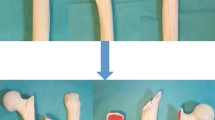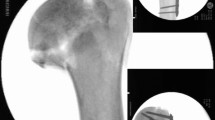Abstract
Background: Reverse oblique trochanteric fracture of femur is a distinct fracture pattern. 95° Dynamic condylar screw (DCS) and proximal femoral nail (PFN) are currently the most commonly used implants for its fixation. This study aims to biomechanically compare the cutout resistance as well as modes of failure of DCS and PFN in reverse oblique trochanteric fractures.
Materials and Methods: Sixteen freshly harvested cadaveric proximal femoral specimens were randomly assigned to three mean bone mineral density matched groups, eight of which were implanted with 95° DCS and the other eight with PFN. The constructs were made unstable to resemble a reverse oblique trochanteric fracture by removing a standard size posteromedial wedge. These constructs were subjected to computer controlled cyclic compressive loading with 200 kg at a frequency of 1 cycle/second (1 Hz) and end points of both the groups were analyzed.
Results: The bending moment of the PFN group was approximately 50% less than that of the DCS group (P<0.0001). The PFN group resisted more number of cycles than the DCS group (P=0.03) and showed lesser number of component failures as compared with the DCS group (P=0.003).
Conclusions: The PFN is biomechanically superior to DCS for the fixation of reverse oblique trochanteric fractures of femur.
Similar content being viewed by others
References
Cummings SR, Rubin SM, Black D. The future of hip fractures in the United States. Numbers, costs, and potential effects of postmenopausal estrogen. Clin Orthop 1990;252:163–6.
Cummings SR, Kelsey JL, Nevitt MC, O’Dowd KJ. Epidemiology of osteoporosis and osteoporotic fractures. Epidemiol Rev 1985;7:178–208.
Haidukewych GJ, Israel TA, Berry DJ. Reverse obliquity fractures of the intertrochanteric region of the femur. J Bone Joint Surg Am 2001;83:643–50.
Koval KJ, Cantu RV. Intertrochanteric fractures. In: Bucholz RW, Heckman JD, Court-Brown CM, eds. Rockwood and Green’s fractures in adults. 6th Ed, vol. 2. Philadelphia: Lippincott Williams and Wilkins; 2006. p. 1793–825.
Baumgaertner MR, Chrostowski JH, Levy RN. Intertrochanteric hip fracture. In: Brown BD, Jupiter JB, Levine AM, Trafton PG, editors. Skeletal trauma: Fractures, dislocations, ligamentous injuries. Philadelphia: WB Saunders; 1998. p.1833–81.
Sanders R, Regazzoni P. Treatment of subtrochanteric femur fractures using the dynamic condylar screw. J Orthop Trauma 1989;3:206–13.
Sadowski C, Lübbeke A, Saudan M, Riand N, Stern R, Hoffmeyer P. Treatment of reverse oblique and transverse intratrochanteric fractures with use of an intramedullary nail or a 95° screw-plate. J Bone Joint Surg Am 2002;84:372–81.
Leung KS, So WS, Shen WY, Hui PW. Gamma nails and dynamic hip screws for peritrochanteric fractures. A randomised prospective study in elderly patients. J Bone Joint Surg Br 1992;74:345–51.
Chila A. Biomechanics. In: Chila A, ed. Foundations of osteopathic medicine. 3rd edition. Philadelphia: Lippincott Williams and Wilkins; 2010. p. 109–110.
Benum P, Grontvedt T, Braten M, Walloe A, Ekeland A, Raugstad S, et al. Gamma nail versus CHS in intertrochanteric and subtrochanteric femoral fractures-a preliminary report of a prospective randomized study. Acta Orthop Scand 1992;63 (Suppl 247):7–8.
Bridle SH, Patel AD, Bircher M, Calvert PT. Fixation of intertrochanteric fractures of the femur. A randomised prospective comparison of the gamma nail and the dynamic hip screw. J Bone Joint Surg Br 1991;73:330–4.
Butt MS, Krikler SJ, Nafie S, Ali MS. Comparison of dynamic hip screw and gamma nail: A prospective, randomized, controlled trial. Injury 1995;26:615–8.
Goldhagen PR, O’Connor DR, Schwarze D, Schwartz E. A prospective comparative study of the compression hip screw and the gamma nail. J Orthop Trauma 1994;8:367–72.
Hardy DC, Descamps PY, Krallis P, Fabeck L, Smets P, Bertens CL, et al. Use of an intramedullary hip-screw compared with a compression hip-screw with a plate for intertrochanteric femoral fractures. A prospective, randomized study of one hundred patients. J Bone Joint Surg Am 1998;80:618–30.
Hoffman CW, Lynskey TG. Intertrochanteric fractures of the femur: A randomized prospective comparison of the Gamma nail and the Ambi hip screw. Aust N Z J Surg 1996;66:151–5.
O’Brien PJ, Meek RN, Blachut PA, Broekhuyse HM, Sabharwal S. Fixation of intertrochanteric hip fractures: Gamma nail versus dynamic hip screw. A randomized, prospective study. Can J Surg 1995;38:516–20.
Radford PJ, Needoff M, Webb JK. A prospective randomised comparison of the dynamic hip screw and the gamma locking nail. J Bone Joint Surg Br 1993;75:789–93.
Simmermacher RK, Bosch AM, Van der Werken C. The AO/ASIFProximal Femoral Nail (PFN): A new device for the treatment of unstable proximal femoral fractures. Injury 1999;30:327–32.
Baumgaertner MR, Curtin SL, Lindskog DM. Intramedullary versus extramedullary fixation for the treatment of intertrochanteric hip fractures. Clin Orthop 1998;348:87–94.
Bess RJ, Jolly SA. Comparison of compression hip screw and gamma nail for treatment of peritrochanteric fractures. J South Orthop Assoc 1997;6:73–9.
Cole JD, Ansel LJ. Intramedullary nail and lag-screw fixation of proximal femur fractures. Operative technique and preliminary results. Orthop Rev 1994;Suppl:35–44.
Fornander P, Thorngren KG, Tornquist H, Ahrengart L, Lindgren U. Swedish experience of the first 209 randomized patients with gamma nail vs. screw-plate. Acta Orthop Scand 1992;63(Suppl 248):90.
Guyer P, Landolt M, Eberle C, Keller H. The gamma-nail as a resilient alternative to the dynamic hip screw in unstable proximal femoral fractures in the elderly. Helv Chir Acta 1992;58:697–703.
Hoffmann R, Schmidmaier G, Schulz R, Schütz M, Südkamp NP. Classic nail versus DHS. A prospective randomised study of fixation of trochanteric femur fractures. Unfallchirurg 1999;102:182–90.
Høgh J, Andersen K, Duus B, Hansen D, Hellberg S, Jakobsen B, et al. Gamma nail versus DHS in the treatment of trochanteric and subtrochanteric fractures. Acta Orthop Scand 1992;63 (Suppl 248):86–7.
Parker MJ, Pryor GA. Gamma versus DHS nailing for extracapsular femoral fractures. Meta-analysis of ten randomised trials. Int Orthop 1996;20:163–8.
Wagner R, Weckbach A, Sellmair U, Blattert T. Extra-articular proximal femur fracture in the elderly-dynamic hip screw or intramedullary hip screw for fracture management?. Langenbecks Arch Chir Suppl Kongressbd 1996;113:963–6.
Babst R, Renner N, Biedermann M, Rosso R, Heberer M, Harder F, et al. Clinical results using the trochanter stabilizing plate (TSP): The modular extension of the dynamic hip screw (DHS) for internal fixation of selected unstable intertrochanteric fractures. J Orthop Trauma 1998;12:392–9.
Hersche O, Heim D, Bodoky A, Regazzoni P. 4 fragment fractures of the proximal femur: Is the dynamic hip screw a suitable implant?. Helv Chir Acta 1989;56:577–80.
Whitelaw GP, Segal D, Sanzone CF, Ober NS, Hadley N. Unstable intertrochanteric/subtrochanteric fractures of the femur. Clin Orthop 1990;252:238–45.
Author information
Authors and Affiliations
Corresponding author
Rights and permissions
About this article
Cite this article
Cheema, G.S., Rastogi, A., Singh, V. et al. Comparison of cutout resistance of dynamic condylar screw and proximal femoral nail in reverse oblique trochanteric fractures: A biomechanical study. IJOO 46, 259–265 (2012). https://doi.org/10.4103/0019-5413.96369
Published:
Issue Date:
DOI: https://doi.org/10.4103/0019-5413.96369




